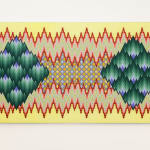Cecilia Charlton American, b. 1985
It might've been a walk-in spirit (according to my 72-year-old Peruvian roommate), 2018
Hand-embroidered wool on canvas over panel
60 x 120 cm
Copyright The Artist
Michael Pollan is an author who wrote ‘How to Change Your Mind: The New Science of Psychedelics’, 2018. The book delves into the rich history of psychedelics in America, tracing...
Michael Pollan is an author who wrote ‘How to Change Your Mind: The New Science of Psychedelics’, 2018. The book delves into the rich history of psychedelics in America, tracing back to the early research in the fifties. He works with neuroscientists who use psychedelics in conjunction with modern brain imaging technologies to probe the mysteries of consciousness and the self.
In the development of these works Cecilia had a compositional curiosity that she wanted to explore. In part I, she wanted to use the bargello patterns themselves to create forms within the work. She wanted to hand the reins over to the patterns to create the shapes, and involving the patterns as her collaborators she intuitively worked through the composition – the patterns took on a life of their own as they merged and overlapped.
In part II, she was curious to see how the patterns might function when fragmented. She created part II in layers, covering the whole surface with the outline of one pattern before covering the rest of the available surface with subsequent fragmented patterns. She approached both of these works with a desire to know more about the bargello patterns themselves – to break them apart and see their components, to "take them out to the highway and let them run at full speed".
These works were important as the foundation of the bargello works that Cecilia has created since, allowing her to learn and familiarise with the individual patterns, in order to use them in a more innovative way.
In the development of these works Cecilia had a compositional curiosity that she wanted to explore. In part I, she wanted to use the bargello patterns themselves to create forms within the work. She wanted to hand the reins over to the patterns to create the shapes, and involving the patterns as her collaborators she intuitively worked through the composition – the patterns took on a life of their own as they merged and overlapped.
In part II, she was curious to see how the patterns might function when fragmented. She created part II in layers, covering the whole surface with the outline of one pattern before covering the rest of the available surface with subsequent fragmented patterns. She approached both of these works with a desire to know more about the bargello patterns themselves – to break them apart and see their components, to "take them out to the highway and let them run at full speed".
These works were important as the foundation of the bargello works that Cecilia has created since, allowing her to learn and familiarise with the individual patterns, in order to use them in a more innovative way.






